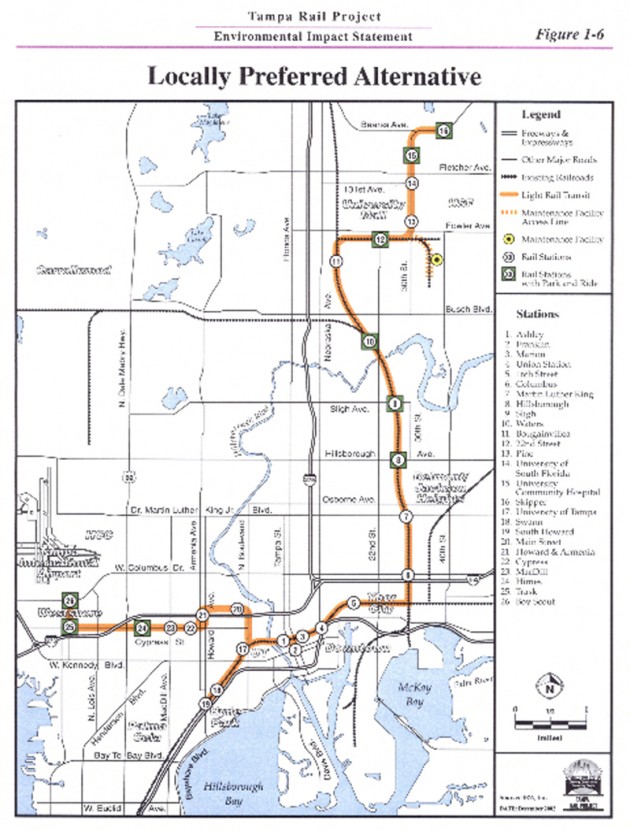Tampa rail proposal centered around USF

Lack of funding has stalled the Tampa Rail Project, an alternative mode of transportation that would connect USF to downtown Tampa.
The 13.3-mile stretch is expected to cost up to $70 million per mile. There are two proposed locations for the TRP, both focused on USF as the core connection.
“The USF (area) performs over and over again as being one of the top corridors as a candidate for light rail, in terms of benefiting,” said Elaine McCloud, mass transit manager for the city of Tampa. “(This is) because of the traffic volume and the demographics of people who live there now, as well as the people who plan to live there.”
One plan projects the rail to run south, parallel to Fowler Avenue, turn north on Bruce B. Downs Boulevard, run past the hospital complex and continue north.
Feeder buses would service rail stations and provide access to and from campus. David Armijo, Hillsborough Area Regional Transit’s (HART) chief executive officer, met with President Judy Genshaft last week to discuss using the Bull Runner as a possible connection. He said those details are coming in the next year.
Another plan features the rail to looping around USF, down Fowler Avenue to 56th Street and back toward 42nd Street.
It is possible the proposed locations could change in the final process, Armijo said.
“Bruce B. Downs has changed a fair amount since the (study) was done in 2002,” he said. “There’s been expansions to some of the medical buildings and official widening of roads and turn lanes and it would be more difficult to fit the project in there and more
expensive.”
Armijo said it could be eight to 10 years before a train is running. He said he thinks the rail system will benefit USF students.
“We have a great performing arts center, the St. Pete Times Forum, all the events that just happened last month with the Super Bowl, Gasparilla and Ybor,” he said. “A lot of great, exciting opportunities. It would be great if people could get on a train and not
have to drive.”
Between 1996 and 2002, HART conducted a study analyzing financial costs and the environmental impact of the Tampa Rail. The Federal Transit Administration approved the $15-million study, but in 2004 the Hillsborough Board of County Commissioners denied a public vote on the study, stopping it in its tracks, said HART spokesman Ed Crawford.
Since then, the HART board stopped annual studies to update the project due to funds.
“At that point in time, the political will wasn’t there to continue spending money on the study,” said Steve Polzin, director of mobility policy research at USF’s Center for Urban Transportation Research. “There just wasn’t a desire to make that kind of investment.”
In order to get federal funding, there must be local funding. Mayor Pam Iorio is proposing a one-cent sales tax increase. There would not be a fee to ride the trains, Armijo said.
Junior Matthew Banas, who did a project for his industrial engineering class using the TRP, said there must be a fee in order for the project to be funded.
“The way to generate money locally would be to charge people to get on there,” he said.
HART plans for the Tampa Rail project to be on a referendum ballot in November 2010.
Future connections would include Tampa International Airport, St. Petersburg and Clearwater.
“Students, as they come in from the airport, can catch a train and make it back to their dormitory or their housing somewhere off campus,” Armijo said.
McCloud said the mayor wants to provide an alternative to driving and transform the area surrounding USF.
“The idea at USF is to have a transit oriented development that eliminates the need for cars altogether,” she said. “A person would walk because of the infrastructure would include sidewalks, retail shops — everything a person would need right there at their fingertips.”
She said the mayor receives daily e-mails from the public supporting the rail system.
“(TRP) would improve air quality in terms of the environment,” McCloud said. “It will act as a catalyst for economic development in terms of creating jobs and of course it will improve the quality of life here for the citizens.”
Ryan Kania, a junior majoring in finance, said he would use the train to participate in downtown events.
“If I was going to Ybor to get messed up or something like that, then I would use that for sure,” he said. “I’m not going to drive when I’m drunk. I would definitely take it.”
Junior Lonitra Benniefield said she rode the bus for four years and wants a faster and easier way to travel.
“I used to think ‘wow, a straight-shot, that’d be really great.’ Driving-wise, even using the bus, it’s very confusing,” Benniefield said. “There’s a lot of one-ways (in downtown).”





